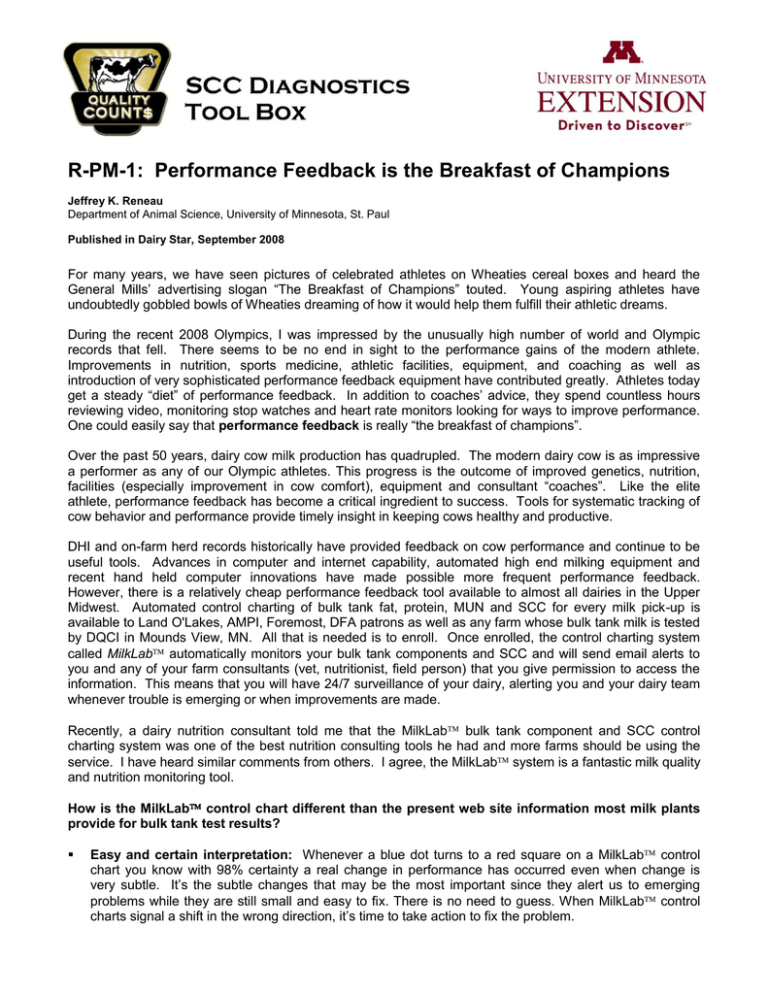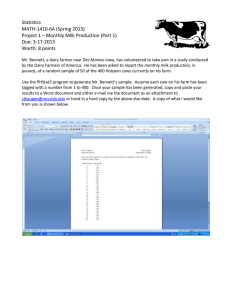R-PM-1: Performance Feedback is the Breakfast of
advertisement

R-PM-1: Performance Feedback is the Breakfast of Champions Jeffrey K. Reneau Department of Animal Science, University of Minnesota, St. Paul Published in Dairy Star, September 2008 For many years, we have seen pictures of celebrated athletes on Wheaties cereal boxes and heard the General Mills’ advertising slogan “The Breakfast of Champions” touted. Young aspiring athletes have undoubtedly gobbled bowls of Wheaties dreaming of how it would help them fulfill their athletic dreams. During the recent 2008 Olympics, I was impressed by the unusually high number of world and Olympic records that fell. There seems to be no end in sight to the performance gains of the modern athlete. Improvements in nutrition, sports medicine, athletic facilities, equipment, and coaching as well as introduction of very sophisticated performance feedback equipment have contributed greatly. Athletes today get a steady “diet” of performance feedback. In addition to coaches’ advice, they spend countless hours reviewing video, monitoring stop watches and heart rate monitors looking for ways to improve performance. One could easily say that performance feedback is really “the breakfast of champions”. Over the past 50 years, dairy cow milk production has quadrupled. The modern dairy cow is as impressive a performer as any of our Olympic athletes. This progress is the outcome of improved genetics, nutrition, facilities (especially improvement in cow comfort), equipment and consultant “coaches”. Like the elite athlete, performance feedback has become a critical ingredient to success. Tools for systematic tracking of cow behavior and performance provide timely insight in keeping cows healthy and productive. DHI and on-farm herd records historically have provided feedback on cow performance and continue to be useful tools. Advances in computer and internet capability, automated high end milking equipment and recent hand held computer innovations have made possible more frequent performance feedback. However, there is a relatively cheap performance feedback tool available to almost all dairies in the Upper Midwest. Automated control charting of bulk tank fat, protein, MUN and SCC for every milk pick-up is available to Land O'Lakes, AMPI, Foremost, DFA patrons as well as any farm whose bulk tank milk is tested by DQCI in Mounds View, MN. All that is needed is to enroll. Once enrolled, the control charting system called MilkLab automatically monitors your bulk tank components and SCC and will send email alerts to you and any of your farm consultants (vet, nutritionist, field person) that you give permission to access the information. This means that you will have 24/7 surveillance of your dairy, alerting you and your dairy team whenever trouble is emerging or when improvements are made. Recently, a dairy nutrition consultant told me that the MilkLab bulk tank component and SCC control charting system was one of the best nutrition consulting tools he had and more farms should be using the service. I have heard similar comments from others. I agree, the MilkLab system is a fantastic milk quality and nutrition monitoring tool. How is the MilkLab control chart different than the present web site information most milk plants provide for bulk tank test results? Easy and certain interpretation: Whenever a blue dot turns to a red square on a MilkLab control chart you know with 98% certainty a real change in performance has occurred even when change is very subtle. It’s the subtle changes that may be the most important since they alert us to emerging problems while they are still small and easy to fix. There is no need to guess. When MilkLab control charts signal a shift in the wrong direction, it’s time to take action to fix the problem. 2 24/7 Surveillance with automatic email alerts: MilkLab allows each person given data access to set both the sensitivity of the alert mechanism as well as setting minimum and maximum levels of any of the milk components or SCC to fit their monitoring needs. For example, if your nutritionist sets a minimum of 3.3% BF, an email will be automatically sent when the BF% has dipped below that level alerting him/her that a diet correction may need to be made before rumen acidosis becomes a health hazard for the herd. Similarly, an alert to the milk plant field person or veterinarian of shifts in the BTSCC provides an early warning of an emerging milk quality problem. A positive shift, on the other hand, can confirm the effectiveness of a recommended product implementation or management change. Performance feedback on every milk pickup on BF, Protein, MUN and SCC is one of the most effective means of knowing whether you are really improving, staying the same or taking a turn for the worse. Control charting systems like MilkLab offer an inexpensive way to make timely adjustments in herd management keeping your cows healthy and productive. Ask your milk plant field person how you can take advantage of this inexpensive service. For more information see http://www.extension.umn.edu/dairy under Quality Count$ Tool Box or contact me at renea001@umn.edu. This document was revised December 2011 for use in University of Minnesota Quality Count$ programs. This material is intended for educational use only and may not be altered in any way but may be reproduced with permission of University of Minnesota Extension Dairy Team.

